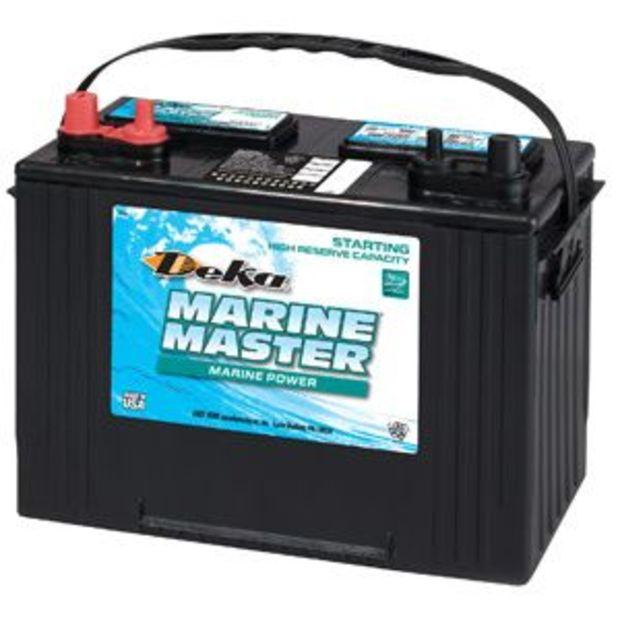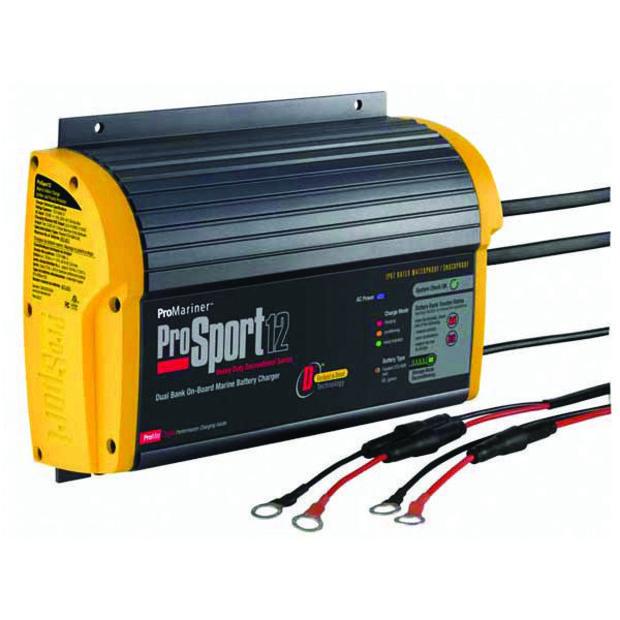By Capt. CD Dollar
Tell me if this sounds familiar: your gear is loaded, cooler packed, and despite the googans gawking at the ramp, the launch goes off without a hiccup. Yet, when you turn the key, all you get is the desperate whine of a starter motor that isn't getting enough juice.
Most of us have been there at one point in our boating lives, and while it isn't quite soul-crushing, it is a major pain in the butt, especially if it happens on Opening Day of the rockfish season. So what caused your boat starter battery to have the life sucked out of it like Willie Loman? Maybe it was a bilge float that got stuck on by debris; perhaps you forgot to turn off the running lights, VHF, fishfinder or stereo. Or perhaps during this long winter hibernation you improperly stored your batteries, the most common battery problem come spring, says Eric Flamino from Stevens' Battery Warehouse in Maryland.
"Batteries that sit unused for long periods of time will self discharge," Flamino says. "Some statistics show that a normal lead acid can self discharge 5-10 percent a month, depending on age (of the battery) and the temperature where it's stored." He recommends charging your batteries overnight on a 6 amp to 10 amp charger every 4-6 weeks to help avoid this problem. Another common practice that works to keep your batteries properly charged is using a "trickle charger" or battery maintainer. More solar trickle chargers have entered the market, enabling you to maintain a good charge on your batteries throughout the season even when away from shore power.

If you know your battery is healthy and fully charged--and you do because the voltmeter reads 12.6v or slightly better at rest--but still won't turn over the motor, check terminal connections and/or ground cables. If your battery is kaput and you're unsure of what kind to buy, get an expert (like Eric) to recommend the correct battery for its intended purpose. In general, there are two basic types of batteries, starting and house, often a deep-cycle. Eric says any decent starting battery of 600 MCA or greater is sufficient to start up to a 200 hp motor. (Personal preference: I always use a starter battery of greater than 600. I like the extra juice. And always check your engine manufacturer's specs since some models call for 1,000 MCA .)
"We offer the Deka Marine Master (Group 24) with 1,000 MCA and 130 minutes of Reserve Capacity, which is the best of both worlds," he said. "It not only affords great starting capacity, and also enough reserve capacity to run lights, fishfinders, radios."
On a related note, a battery switch is a necessity in my opinion. Why? Because it allows you to segregate batteries between systems and/or isolate onboard electrical systems to avoid draining batteries while not in use. The caveat to this is that you need to have at least one bilge pump wired directly to the battery to keep your baby afloat.
By ensuring your batteries are the proper type and fully charged, you can set about enjoying your time on the water. And that's the real reason most of us put up with the headaches of boat ownership, isn't it?
A quick guide to battery lingo:
MCA: Marine Cranking Amps; the amount of amps produced at 32°F.
CCA: Cold Cranking Amps; The number of amps a battery can deliver for 30 seconds a

t 0°F and maintain 7.2 volts.
AGM: Absorbed Glass Mat; increasingly popular due to improved performance over flooded batteries, including greater starting power and quicker recharge rate; usually more expensive than flooded batteries.
Gel Batteries: Sealed, valve-regulated (SVR) gelled-electrolyte batteries; maintenance free and leakproof; usually requires carefully regulated smart charging to prevent damage; expensive.
Battery Group: Refers to the physical size of the battery; separated into "groups" (Group 24, 27, 29, 31); 4D and 8D suitable for large diesel engines.
Dos & Don'ts
DO: Stay with one battery chemistry (flooded, gel or AGM). Mixing battery types can result in under- or over-charging.
DON'T: Mix old batteries with new ones in the same bank. Old batteries, like negative people, often pull down the new ones to their deteriorated state.
DO: Keep batteries clean, cool and dry. Check terminal connectors regularly to avoid loss of conductivity. Clean corrosion with baking soda and water mixture.
DON'T: Leave batteries in a discharged state; this damages them and lowers their capacity.
 If you know your battery is healthy and fully charged--and you do because the voltmeter reads 12.6v or slightly better at rest--but still won't turn over the motor, check terminal connections and/or ground cables. If your battery is kaput and you're unsure of what kind to buy, get an expert (like Eric) to recommend the correct battery for its intended purpose. In general, there are two basic types of batteries, starting and house, often a deep-cycle. Eric says any decent starting battery of 600 MCA or greater is sufficient to start up to a 200 hp motor. (Personal preference: I always use a starter battery of greater than 600. I like the extra juice. And always check your engine manufacturer's specs since some models call for 1,000 MCA .)
"We offer the Deka Marine Master (Group 24) with 1,000 MCA and 130 minutes of Reserve Capacity, which is the best of both worlds," he said. "It not only affords great starting capacity, and also enough reserve capacity to run lights, fishfinders, radios."
On a related note, a battery switch is a necessity in my opinion. Why? Because it allows you to segregate batteries between systems and/or isolate onboard electrical systems to avoid draining batteries while not in use. The caveat to this is that you need to have at least one bilge pump wired directly to the battery to keep your baby afloat.
By ensuring your batteries are the proper type and fully charged, you can set about enjoying your time on the water. And that's the real reason most of us put up with the headaches of boat ownership, isn't it?
A quick guide to battery lingo:
MCA: Marine Cranking Amps; the amount of amps produced at 32°F.
CCA: Cold Cranking Amps; The number of amps a battery can deliver for 30 seconds a
If you know your battery is healthy and fully charged--and you do because the voltmeter reads 12.6v or slightly better at rest--but still won't turn over the motor, check terminal connections and/or ground cables. If your battery is kaput and you're unsure of what kind to buy, get an expert (like Eric) to recommend the correct battery for its intended purpose. In general, there are two basic types of batteries, starting and house, often a deep-cycle. Eric says any decent starting battery of 600 MCA or greater is sufficient to start up to a 200 hp motor. (Personal preference: I always use a starter battery of greater than 600. I like the extra juice. And always check your engine manufacturer's specs since some models call for 1,000 MCA .)
"We offer the Deka Marine Master (Group 24) with 1,000 MCA and 130 minutes of Reserve Capacity, which is the best of both worlds," he said. "It not only affords great starting capacity, and also enough reserve capacity to run lights, fishfinders, radios."
On a related note, a battery switch is a necessity in my opinion. Why? Because it allows you to segregate batteries between systems and/or isolate onboard electrical systems to avoid draining batteries while not in use. The caveat to this is that you need to have at least one bilge pump wired directly to the battery to keep your baby afloat.
By ensuring your batteries are the proper type and fully charged, you can set about enjoying your time on the water. And that's the real reason most of us put up with the headaches of boat ownership, isn't it?
A quick guide to battery lingo:
MCA: Marine Cranking Amps; the amount of amps produced at 32°F.
CCA: Cold Cranking Amps; The number of amps a battery can deliver for 30 seconds a t 0°F and maintain 7.2 volts.
AGM: Absorbed Glass Mat; increasingly popular due to improved performance over flooded batteries, including greater starting power and quicker recharge rate; usually more expensive than flooded batteries.
Gel Batteries: Sealed, valve-regulated (SVR) gelled-electrolyte batteries; maintenance free and leakproof; usually requires carefully regulated smart charging to prevent damage; expensive.
Battery Group: Refers to the physical size of the battery; separated into "groups" (Group 24, 27, 29, 31); 4D and 8D suitable for large diesel engines.
Dos & Don'ts
DO: Stay with one battery chemistry (flooded, gel or AGM). Mixing battery types can result in under- or over-charging.
DON'T: Mix old batteries with new ones in the same bank. Old batteries, like negative people, often pull down the new ones to their deteriorated state.
DO: Keep batteries clean, cool and dry. Check terminal connectors regularly to avoid loss of conductivity. Clean corrosion with baking soda and water mixture.
DON'T: Leave batteries in a discharged state; this damages them and lowers their capacity.
t 0°F and maintain 7.2 volts.
AGM: Absorbed Glass Mat; increasingly popular due to improved performance over flooded batteries, including greater starting power and quicker recharge rate; usually more expensive than flooded batteries.
Gel Batteries: Sealed, valve-regulated (SVR) gelled-electrolyte batteries; maintenance free and leakproof; usually requires carefully regulated smart charging to prevent damage; expensive.
Battery Group: Refers to the physical size of the battery; separated into "groups" (Group 24, 27, 29, 31); 4D and 8D suitable for large diesel engines.
Dos & Don'ts
DO: Stay with one battery chemistry (flooded, gel or AGM). Mixing battery types can result in under- or over-charging.
DON'T: Mix old batteries with new ones in the same bank. Old batteries, like negative people, often pull down the new ones to their deteriorated state.
DO: Keep batteries clean, cool and dry. Check terminal connectors regularly to avoid loss of conductivity. Clean corrosion with baking soda and water mixture.
DON'T: Leave batteries in a discharged state; this damages them and lowers their capacity.